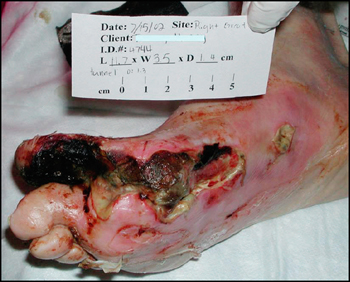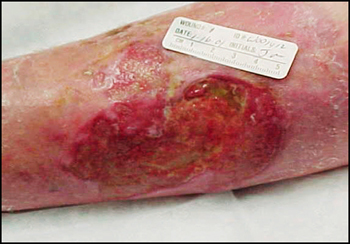What chronic wounds are causing a health care crisis?
Chronic wounds remain in a chronic inflammatory state and therefore fail to follow normal patterns of the healing process. These wounds are a major health problem in the United States and throughout the world.
Three principle types of chronic wounds are diabetic foot ulcers, venous leg ulcers, and pressure ulcers, although other wounds, such as surgical wounds, can also become chronic.
Diabetic foot ulcers

Diabetics are prone to foot ulcers due to peripheral neuropathy: decreased sensation caused by this condition can result in a cut and trauma to the foot going unnoticed or can result in unusual pressures being placed on the foot. Diabetic foot ulcers are the most significant wound care problem in the United States and the world. There are now over 60 million diabetic patients in the United States, with an incidence of foot ulcers of approximately 20-25 percent over the patient’s lifetime. Currently, there are approximately 100,000 limb amputations performed in diabetic patients each year in the United States. The exact cost of care for diabetic foot ulcers is difficult to determine, but is likely to be measured in billions of dollars.
Diabetes and, therefore, diabetic foot ulcer complications are growing at double digit rates and have the potential of becoming even a more devastating epidemic.
Venous leg ulcers

Venous leg ulcers are caused by a failure of valves in the veins of the legs, resulting in congestion and slowing of blood flow. These ulcers can occur spontaneously or in association with minor trauma to the leg. Venous leg ulcers are often very painful. A survey by Nelzen established a prevalence of venous leg ulcers of 0.16 percent in Sweden (Nelzen et. al., 1994). Fifty-four percent of patients had their venous leg ulcers for more than one year. This survey also demonstrated that as the population ages, venous leg ulcers are more common. In 1985 the estimated annual cost of treatment in Scandinavia for venous leg ulcers was $25 million.
In 1989 the estimated cost for managing venous leg ulcers was $200 million in the United Kingdom. Although the cost of venous leg ulcers in the United States has not been formally calculated, the costs of treatment have been projected at $1 billion per year in 1992, and the scope of the problem has continued to increase yearly.
Pressure ulcers

Pressure ulcers, also termed decubitis ulcers or bed sores, result from pressure on skin, soft tissue, muscle, and bone that exceeds capillary-filling pressure for an extended period of time. These wounds occur in individuals that are unable to sense the pressure or are unable to change their body position to relieve the pressure. Pressure ulcers are a common and expensive problem in acute care, nursing home, and home care populations. The total cost of pressure ulcer treatment in the United States is estimated to exceed $1.3 billion. In hospital settings the incidence of pressure ulcers has ranged from 2.7% to 29.5%.
In the most extensive study of acute care facilities, Meehan surveyed 148 hospitals and found the prevalence of pressure ulcers was 9.2%. The prevalence of pressure ulcers in subjects cared for in skilled care facilities and nursing homes has been reported to range from 2.4% to 23%. Rates obtained in incidence studies in this population fell within a comparable range. In summary, the incidence and prevalence of pressure ulcers is sufficiently high to warrant a great deal of concern based upon the morbidity of the problem and the high cost to the health care system.
